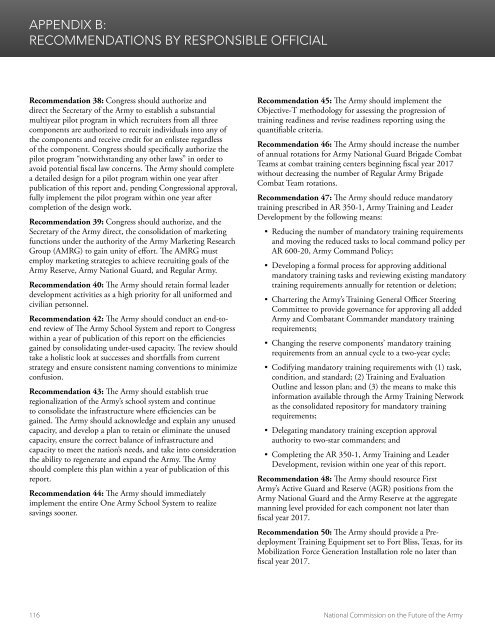THE FUTURE OF THE ARMY
Futurearmy
Futurearmy
You also want an ePaper? Increase the reach of your titles
YUMPU automatically turns print PDFs into web optimized ePapers that Google loves.
APPENDIX B:<br />
RECOMMENDATIONS BY RESPONSIBLE <strong>OF</strong>FICIAL<br />
Recommendation 38: Congress should authorize and<br />
direct the Secretary of the Army to establish a substantial<br />
multiyear pilot program in which recruiters from all three<br />
components are authorized to recruit individuals into any of<br />
the components and receive credit for an enlistee regardless<br />
of the component. Congress should specifically authorize the<br />
pilot program “notwithstanding any other laws” in order to<br />
avoid potential fiscal law concerns. The Army should complete<br />
a detailed design for a pilot program within one year after<br />
publication of this report and, pending Congressional approval,<br />
fully implement the pilot program within one year after<br />
completion of the design work.<br />
Recommendation 39: Congress should authorize, and the<br />
Secretary of the Army direct, the consolidation of marketing<br />
functions under the authority of the Army Marketing Research<br />
Group (AMRG) to gain unity of effort. The AMRG must<br />
employ marketing strategies to achieve recruiting goals of the<br />
Army Reserve, Army National Guard, and Regular Army.<br />
Recommendation 40: The Army should retain formal leader<br />
development activities as a high priority for all uniformed and<br />
civilian personnel.<br />
Recommendation 42: The Army should conduct an end-toend<br />
review of The Army School System and report to Congress<br />
within a year of publication of this report on the efficiencies<br />
gained by consolidating under-used capacity. The review should<br />
take a holistic look at successes and shortfalls from current<br />
strategy and ensure consistent naming conventions to minimize<br />
confusion.<br />
Recommendation 43: The Army should establish true<br />
regionalization of the Army’s school system and continue<br />
to consolidate the infrastructure where efficiencies can be<br />
gained. The Army should acknowledge and explain any unused<br />
capacity, and develop a plan to retain or eliminate the unused<br />
capacity, ensure the correct balance of infrastructure and<br />
capacity to meet the nation’s needs, and take into consideration<br />
the ability to regenerate and expand the Army. The Army<br />
should complete this plan within a year of publication of this<br />
report.<br />
Recommendation 44: The Army should immediately<br />
implement the entire One Army School System to realize<br />
savings sooner.<br />
Recommendation 45: The Army should implement the<br />
Objective-T methodology for assessing the progression of<br />
training readiness and revise readiness reporting using the<br />
quantifiable criteria.<br />
Recommendation 46: The Army should increase the number<br />
of annual rotations for Army National Guard Brigade Combat<br />
Teams at combat training centers beginning fiscal year 2017<br />
without decreasing the number of Regular Army Brigade<br />
Combat Team rotations.<br />
Recommendation 47: The Army should reduce mandatory<br />
training prescribed in AR 350-1, Army Training and Leader<br />
Development by the following means:<br />
• Reducing the number of mandatory training requirements<br />
and moving the reduced tasks to local command policy per<br />
AR 600-20, Army Command Policy;<br />
• Developing a formal process for approving additional<br />
mandatory training tasks and reviewing existing mandatory<br />
training requirements annually for retention or deletion;<br />
• Chartering the Army’s Training General Officer Steering<br />
Committee to provide governance for approving all added<br />
Army and Combatant Commander mandatory training<br />
requirements;<br />
• Changing the reserve components’ mandatory training<br />
requirements from an annual cycle to a two-year cycle;<br />
• Codifying mandatory training requirements with (1) task,<br />
condition, and standard; (2) Training and Evaluation<br />
Outline and lesson plan; and (3) the means to make this<br />
information available through the Army Training Network<br />
as the consolidated repository for mandatory training<br />
requirements;<br />
• Delegating mandatory training exception approval<br />
authority to two-star commanders; and<br />
• Completing the AR 350-1, Army Training and Leader<br />
Development, revision within one year of this report.<br />
Recommendation 48: The Army should resource First<br />
Army’s Active Guard and Reserve (AGR) positions from the<br />
Army National Guard and the Army Reserve at the aggregate<br />
manning level provided for each component not later than<br />
fiscal year 2017.<br />
Recommendation 50: The Army should provide a Predeployment<br />
Training Equipment set to Fort Bliss, Texas, for its<br />
Mobilization Force Generation Installation role no later than<br />
fiscal year 2017.<br />
116 National Commission on the Future of the Army


